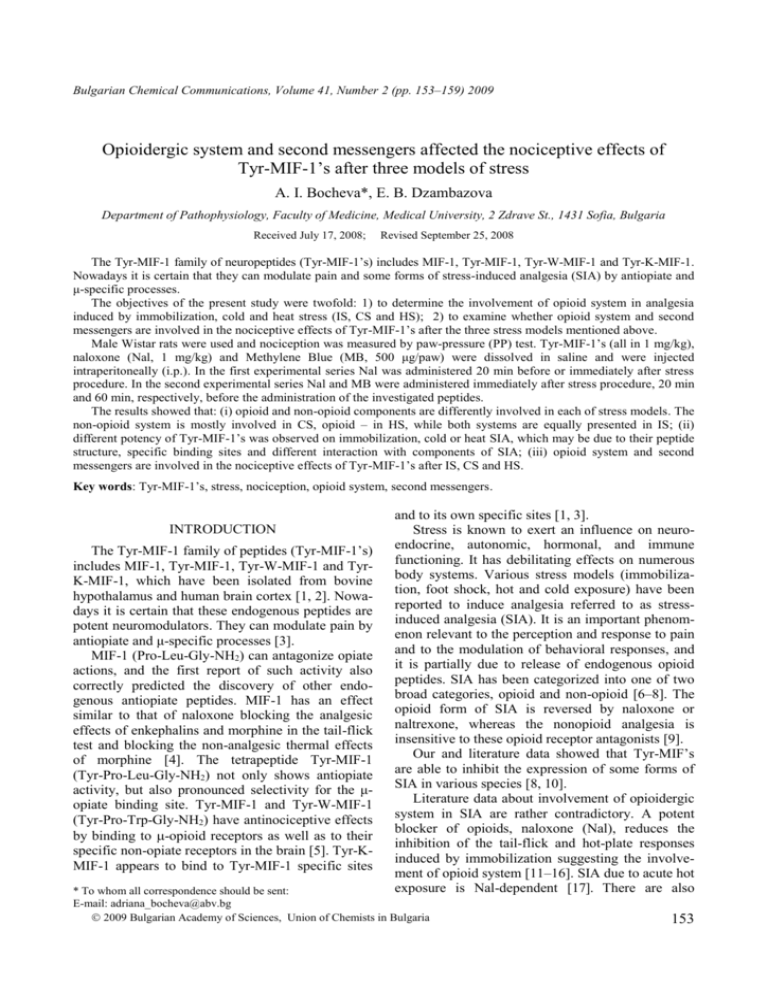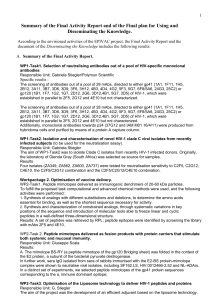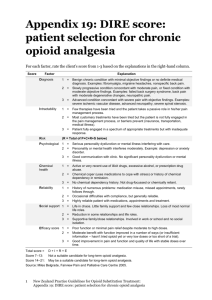2900-R - Bulgarian Chemical Communications
advertisement

Bulgarian Chemical Communications, Volume 41, Number 2 (pp. 153–159) 2009 Opioidergic system and second messengers affected the nociceptive effects of Tyr-MIF-1’s after three models of stress A. I. Bocheva*, E. B. Dzambazova Department of Pathophysiology, Faculty of Medicine, Medical University, 2 Zdrave St., 1431 Sofia, Bulgaria Received July 17, 2008; Revised September 25, 2008 The Tyr-MIF-1 family of neuropeptides (Tyr-MIF-1’s) includes MIF-1, Tyr-MIF-1, Tyr-W-MIF-1 and Tyr-K-MIF-1. Nowadays it is certain that they can modulate pain and some forms of stress-induced analgesia (SIA) by antiopiate and μ-specific processes. The objectives of the present study were twofold: 1) to determine the involvement of opioid system in analgesia induced by immobilization, cold and heat stress (IS, CS and HS); 2) to examine whether opioid system and second messengers are involved in the nociceptive effects of Tyr-MIF-1’s after the three stress models mentioned above. Male Wistar rats were used and nociception was measured by paw-pressure (PP) test. Tyr-MIF-1’s (all in 1 mg/kg), naloxone (Nal, 1 mg/kg) and Methylene Blue (MB, 500 μg/paw) were dissolved in saline and were injected intraperitoneally (i.p.). In the first experimental series Nal was administered 20 min before or immediately after stress procedure. In the second experimental series Nal and MB were administered immediately after stress procedure, 20 min and 60 min, respectively, before the administration of the investigated peptides. The results showed that: (i) opioid and non-opioid components are differently involved in each of stress models. The non-opioid system is mostly involved in CS, opioid – in HS, while both systems are equally presented in IS; (ii) different potency of Tyr-MIF-1’s was observed on immobilization, cold or heat SIA, which may be due to their peptide structure, specific binding sites and different interaction with components of SIA; (iii) opioid system and second messengers are involved in the nociceptive effects of Tyr-MIF-1’s after IS, CS and HS. Key words: Tyr-MIF-1’s, stress, nociception, opioid system, second messengers. INTRODUCTION The Tyr-MIF-1 family of peptides (Tyr-MIF-1’s) includes MIF-1, Tyr-MIF-1, Tyr-W-MIF-1 and TyrK-MIF-1, which have been isolated from bovine hypothalamus and human brain cortex [1, 2]. Nowadays it is certain that these endogenous peptides are potent neuromodulators. They can modulate pain by antiopiate and μ-specific processes [3]. MIF-1 (Pro-Leu-Gly-NH2) can antagonize opiate actions, and the first report of such activity also correctly predicted the discovery of other endogenous antiopiate peptides. MIF-1 has an effect similar to that of naloxone blocking the analgesic effects of enkephalins and morphine in the tail-flick test and blocking the non-analgesic thermal effects of morphine [4]. The tetrapeptide Tyr-MIF-1 (Tyr-Pro-Leu-Gly-NH2) not only shows antiopiate activity, but also pronounced selectivity for the μopiate binding site. Tyr-MIF-1 and Tyr-W-MIF-1 (Tyr-Pro-Trp-Gly-NH2) have antinociceptive effects by binding to -opioid receptors as well as to their specific non-opiate receptors in the brain [5]. Tyr-KMIF-1 appears to bind to Tyr-MIF-1 specific sites and to its own specific sites [1, 3]. Stress is known to exert an influence on neuroendocrine, autonomic, hormonal, and immune functioning. It has debilitating effects on numerous body systems. Various stress models (immobilization, foot shock, hot and cold exposure) have been reported to induce analgesia referred to as stressinduced analgesia (SIA). It is an important phenomenon relevant to the perception and response to pain and to the modulation of behavioral responses, and it is partially due to release of endogenous opioid peptides. SIA has been categorized into one of two broad categories, opioid and non-opioid [6–8]. The opioid form of SIA is reversed by naloxone or naltrexone, whereas the nonopioid analgesia is insensitive to these opioid receptor antagonists [9]. Our and literature data showed that Tyr-MIF’s are able to inhibit the expression of some forms of SIA in various species [8, 10]. Literature data about involvement of opioidergic system in SIA are rather contradictory. A potent blocker of opioids, naloxone (Nal), reduces the inhibition of the tail-flick and hot-plate responses induced by immobilization suggesting the involvement of opioid system [11–16]. SIA due to acute hot exposure is Nal-dependent [17]. There are also * To whom all correspondence should be sent: E-mail: adriana_bocheva@abv.bg 2009 Bulgarian Academy of Sciences, Union of Chemists in Bulgaria 153 A. I. Bocheva and E. B. Dzambazova: Opioidergic system and second messengers effects investigators who claim that the opioid system is not engaged in the nociceptive responses since Nal does not affect immobilization stress-induced antinociception in male mice [18, 19]. Also, Nal has no effect on cold SIA [17] or administered before the cold stress it blocks SIA [20]. The objectives of the present study were twofold: 1) to determine the involvement of opioid system in analgesia induced by immobilization, cold and heat stress (IS, CS and HS); 2) to examine whether opioid system and second messengers are involved in the nociceptive effects of Tyr-MIF-1’s after the three stress models mentioned above. EXPERIMENTAL Chemistry. The synthesis of Tyr-MIF-1 peptides was based on well-established methods of peptides synthesis. For optimization purposes, three different activation procedures were used: mixed anhydride (MA), dicyclohexyl carbodimide (DCC/HOBt) or active ester (AE) methods. The strategy of the minimal side-chain protection was adopted [21]. After isolation and purification, the peptides were identified and characterized by optical rotation, TLC, analytical HPLC, mass-spectra and elemental analysis. Animals. The experiments were carried out on male Wistar rats (180–200 g) housed at 12 h light/dark cycle. Food and water were available ad libitum. All experiments were carried out between 09.00 a.m./12.00 p.m. Each group included 8–10 rats. Nociceptive test: Paw-pressure (PP) test. The changes in the mechanical nociceptive threshold of the rats were measured by analgesimeter (Ugo Basile). The pressure was applied to the hind-paw. The pressure (grams) required eliciting nociceptive responses such as squeak and struggle was taken as the mechanical nociceptive threshold. A cut-off value of 500 g was used to prevent damage of the paw. Acute models of stress: Immobilization stress (IS). The animals were placed in a plastic tube with adjustable plaster tape on the outside so that the animals were unable to move. There were holes for breathing. The control group was not submitted to restraint. The immobilization procedure was carried out for 1 hour; Cold stress (CS). The animals were placed in a refrigerating chamber at 4ºC. The cold stress procedure was carried out for 1 hour; Heat stress (HS). Each rat of this group was subjected for a single exposure in the incubator at a temperature of 38 ± 1°C and relative humidity of 154 45–50% for one hour. Drugs and treatment. MIF-1, Tyr-MIF-1, TyrW-MIF-1 and Tyr-K-MIF-1 (all at a dose of 1 mg/kg) were synthesized by the Group of Antimetabolites at the Institute of Molecular Biology, Bulgarian Academy of Sciences. Naloxone (Nal, 1 mg/kg) and Methylene Blue (MB, 500 μg/paw), an inhibitor of activation of guanylyl cyclase and NOsynthase, were obtained from Sigma. All drugs were dissolved in sterile saline (0.9% NaCl) solution. Peptides and Nal were injected intraperitoneally (i.p.). In the first experimental series Nal was administered 20 min before or immediately after stress procedure. In the second experimental series, Nal and MB were administered immediately after stress procedure, 20 min and 60 min, respectively, before the administration of the investigated peptides. The experiment began 15 min after injection of Tyr-MIF-1’s. The control group was injected with saline 1ml/kg, i.p. The experimental procedures were carried out in accordance with the institutional guidance and general recommendations on the use of animals for scientific purposes. Data analysis. The results were statistically assessed by one-way analysis of variance (ANOVA). Values are mean ± S.E.M. Values of P < 0.05 were considered to indicate statistical significance. RESULTS AND DISCUSSION In the first experimental series we determined involvement of opioid system in analgesia induced by IS, CS and HS using a non-competitive antagonist of opiate receptors Nal (1 mg/kg, i.p.). It was administered 20 min before or immediately after stress procedure. In the first case the changes in analgesia were measured immediately after stress, while in the second case – 20 min later (Fig. 1). Our results showed that IS, CS and HS have well-pronounced analgesic effects compared to the control (Figs. 1–4). Administration of Nal (1 mg/kg, i.p.) immediately after IS decreased significantly the pain threshold measured 20 min after injection of Nal (P < 0.01). Nal injected 20 min before IS did not show significant change in pain threshold compare to immobilization-SIA (ISIA) measured immediately after stress procedure. The obtained results for CS were similar. Nal injected immediately after CS decreased significantly cold-SIA (CSIA) when the pain threshold was measured 20 min later (P < 0.05). In contrast, Nal adminis- tered 20 min before HS or immediately after it strongly inhibited heatSIA (HSIA) (P < 0.001) (Fig. 1). A. I. Bocheva and E. B. Dzambazova: Opioidergic system and second messengers effects 300 250 * 2 2 Paw pressure (g/cm ) 100 75 50 200 2 Paw pressure (g/cm ) ++ Paw pressure (g/cm ) 125 200 100 150 100 50 25 0 0 0 contr ol Nal bIS Nal 1h IS min min 400 + 250 +++ 2 Paw pressure (g/cm ) 200 2 Paw pressure (g/cm ) ++ Nal bCS Nal aIS 150 100 +++ 300 200 100 50 0 0 1h IS min Nal aIS Nal bCS 1h CS Nal aCS min Nal bHS 1h HS Nal aHS min Fig. 1. Effects of naloxone (Nal), immobilization stress (IS), cold stress (CS) and heat stress (HS) on nociception measured with paw pressure (PP) test. Also administration of Nal (1 mg/kg, i.p.) before (Nal bIS, Nal bCS, Nal bHS) and after each of stress procedure (Nal aIS, Nal aCS, Nal aHS) in male Wistar rats (n = 5). Mean values ± S.E.M. are presented. *P < 0.05 vs. control; +P < 0.05, ++P < 0.01, +++P < 0.001 vs. respective stress. In the second experimental series we examined the involvement of opioid system and second messengers in the nociceptive effects of Tyr-MIF1’s after the three stress models using Nal (applied immediately after stress procedure and 20 min before peptide) and MB (applied immediately after stress procedure and 60 min before peptide). The peptides applied alone were injected just after the stress procedure. The investigation started 15 min after peptides injection. MIF-1 (P < 0.01), Tyr-MIF-1 (P < 0.01), and Tyr-K-MIF-1 (P < 0.05) (all at a dose of 1 mg/kg, i.p.) significantly decreased the pain threshold compared to the group of animals with ISIA (Fig. 2). Tyr-W-MIF-1 (P < 0.05) significantly decreased the pain threshold compared to IS 30 min after its injection (not shown in the figure). Combination of peptides with Nal or MB (with exception of MIF-1) after IS significantly decreased the pain threshold compared to respective peptide (Fig. 2). Only two of the investigated peptides, Tyr-MIF1 (P < 0.05) and Tyr-K-MIF-1 (P < 0.05) injected alone after CS, significantly inhibited CSIA (Fig. 3). Tyr-W-MIF-1 (P < 0.05) showed the same effect 30 min later (not shown in the figure). Tyr-MIF-1 (P < 0.01), Tyr-W-MIF-1 (P < 0.01) and Tyr-K-MIF-1 (P < 0.01) significantly decreased the pain threshold compared to HSIA (Fig. 4). MIF-1 (P < 0.05) did not show any effect on CSIA or HSIA. Co-administration of all peptides with Nal or MB after CS or HS significantly decreased the pain threshold compared to the respective peptide (Figs. 3 and 4). The analgesia induced by stress is an adaptive response that occurs both in laboratory animals and humans. Opiod and non-opioid pain inhibitory pathways appear to be activated by such stimuli [6]. The SIA is classified as opioid when it is anta- 155 A. I. Bocheva and E. B. Dzambazova: Opioidergic system and second messengers effects gonized by naloxone and non-opioid when different mediators such as dopamine, histamine, serotonin or excitatory amino acids seem to be mainly responsible for the analgesic effects observed after certain stress conditions [22]. A lot of literature documents demonstrated that the parameters of the laboratory stressor will determine the neurochemical identity of the resultant analgesia. In rats, low severity stressors produce opioid analgesia and higher severity stressors produce nonopioid analgesia [23]. 400 2 Paw pressure (g/cm ) ** 300 200 ** ** ** * ** + ** ** ** +++ +++ ** ** ** +++ +++ +++ control 1h IS MIF-1 Nal+MIF-1 MB+MIF-1 Tyr-MIF-1 Nal+Tyr-MIF-1 MB+Tyr-MIF-1 Tyr-W-MIF-1 Nal+Tyr-W-MIF-1 MB+Tyr-W-MIF-1 Tyr-K-MIF-1 Nal+Tyr-K-MIF-1 MB+Tyr-K-MIF-1 100 0 15 min after peptide injection Fig. 2. Effects of MIF-1, Tyr-MIF-1, Tyr-W-MIF-1, Tyr-K-MIF-1 (all in 1 mg/kg, i.p.) and their combination with Nal (1 mg/kg, i.p.) and methylene blue (MB, 500 μg/paw) on nociception measured with paw pressure (PP) test after 1 hour immobilisation stress (IS) in male Wistar rats (n = 5). Mean values ± S.E.M. are presented. *P < 0.05, **P < 0.01 vs. IS; + P < 0.05, +++P < 0.001 vs. respective peptide. control 1h CS MIF-1 Nal+MIF-1 MB+MIF-1 Tyr-MIF-1 200 2 Paw pressure (g/cm ) 250 * +++ * * ** +++ 150 ** ** Nal+Tyr-MIF-1 ** ** +++ +++ ** ** +++ +++ 100 MB+Tyr-MIF-1 Tyr-W-MIF-1 Nal+Tyr-W-MIF-1 MB+Tyr-W-MIF-1 Tyr-K-MIF-1 Nal+Tyr-K-MIF-1 50 MB+Tyr-K-MIF-1 0 15 min after peptide injection Fig. 3. Effects of MIF-1, Tyr-MIF-1, Tyr-W-MIF-1, Tyr-K-MIF-1 (all in 1 mg/kg, i.p.) and their combination with Nal (1 mg/kg, i.p.) and methylene blue (MB, 500 μg/paw) on nociception measured with paw pressure (PP) test after 1 hour cold stress (CS) in male Wistar rats (n = 5). Mean values ± S.E.M. are presented. *P < 0.05, **P < 0.01 vs. CS; +++ P < 0.001 vs. respective peptide. 156 A. I. Bocheva and E. B. Dzambazova: Opioidergic system and second messengers effects control 1h HS MIF-1 Nal+MIF-1 2 Paw pressure (g/cm ) 400 300 ** ** 200 ** ** 100 ** ++ ** ** +++ +++ ** ** +++ +++ ** +++ ** MB+MIF-1 Tyr-MIF-1 Nal+Tyr-MIF-1 MB+Tyr-MIF-1 Tyr-W-MIF-1 Nal+Tyr-W-MIF-1 MB+Tyr-W-MIF-1 Tyr-K-MIF-1 Nal+Tyr-K-MIF-1 MB+Tyr-K-MIF-1 +++ 0 15 min after peptide injection Fig. 4. Effects of MIF-1, Tyr-MIF-1, Tyr-W-MIF-1, Tyr-K-MIF-1 (all in 1 mg/kg, i.p.) and their combination with Nal (1 mg/kg, i.p.) and methylene blue (MB, 500 μg/paw) on nociception measured with paw pressure (PP) test after 1 hour heat stress (HS) in male Wistar rats (n = 5). Mean values ± S.E.M. are presented. **P < 0.01 vs. HS; ++ P < 0.01, +++P < 0.001 vs. respective peptide. According to the obtain results, the opioid system is involved in the three models of stress. Nal showed effect administered after each of stress exposures. The greatest influence was observed on HSIA. These results and literature data showed that opioid and non-opioid components are differently involved in each of stress models. The non-opioid system is mostly involved in CS, opioid – in HS, while both systems are equally presented in IS [24]. We confirm some findings that there is the so called mixed form of SIA, which possesses opioid and non-opioid components. The observed different potency of Tyr-MIF-1 peptides may be due to their peptide structure, specific binding sites and different interaction with opioid or non-opioid components of the three stress models – IS, CS and HS. In particular, Tyr-MIF-1`s have anti-opioid properties, since they decreased the effect of morphine, L-NAME and some forms of SIA [2, 3, 10]. Our results are in accordance with some literature data that Tyr-MIF-1 modulates stress responses in mice. Authors suggest that the peptide regulates the endogenous biological alert system responding to stress exposure, perhaps, counteracting the excessive response of the system [25]. It is known that different kinds of stress are known to alter the brain neurohormones and neuronal activities [26]. The endogenous peptide Tyr-MIF-1 has been shown to have modulating activity on the endogenous opiates released with SIA [1, 27]. In particular, Tyr-MIF-1 induces inhibitory effects on analgesia induced by shock, novel-environment and warm water-swim [28], defeat-induced analgesia and inhibition of aggression [29] and restraint induced analgesia in the mouse [30]. Opioid system and second messengers are involved in the nociceptive effects of Tyr-MIF-1’s after IS, CS and HS since Nal and MB altered the pain thresholds of peptides. CONCLUSIONS i. Opioid and non-opioid components are differently involved in each of the stress models. The non-opioid system is mostly involved in CS, opioid – in HS, while both systems are equally presented in IS. ii. Different potency of Tyr-MIF-1’s was observed on immobilization, cold or heat SIA. This results may be due to their peptide structure, specific binding sites and different interaction with opioid or non-opioid components of SIA. iii. Opioid system and second messengers are involved in the nociceptive effects of Tyr-MIF-1’s after IS, CS and HS. Acknowledgments: This work was supported by grant of the Bulgarian National Scientific Research Foundation VU-L-04/05. 157 A. I. Bocheva and E. B. Dzambazova: Opioidergic system and second messengers effects REFERENCES 1. G. W. Reed, G. A. Olson, R. D. Olson, Neurosci. Biobehav., 18, 519 (1994). 2. F. Cesselin, Fundam. Clin. Pharmacol., 9, 409 (1995). 3. W. Pan, A. J. Kastin, Peptides, 28, 2411 (2007). 4. J. E. Zadina, A. J. Kastin, L. J. Ge, V. Brantl, Life Sci., 47, 25 (1990). 5. J. E. Zadina, A. J. Kastin, L. J. Ge, L. Hackler, Life Sci., 55, 461 (1994). 6. L. R. Watkins, D. J. Mayer, Ann. N Y Acad. Sci., 467, 273 (1986). 7. A. Tsuda, Y. Ida, H. Satoh, S. Tsujimaru, M. Tanaka, Parmacol. Biochem. Behav., 32, 569 (1989). 8. M. Inoue, M. H. Rashid, T. Kawashima, M. Matsumoto, T. Maeda, S. Kishioka, H. Ueda, Brain Res. Bull., 60, 275 (2003). 9. I. B. Lapo, M. Konarzewski, B. Sadowski, Physiol. Behav., 78, 345 (2003). 10. A. Bocheva, E. Dzambazova-Maximova, Meth. Find. Clin. Exp. Pharmacol., 26, 673 (2004). 11. S. Amir, Z. Amit, Life Sci., 23, 1143 (1978). 12. B. D. Appelbaum, S. G. Holtzman, Life Sci., 36, 1069 (1985). 13. D. B. Miller, Brain Res., 473, 327 (1988). 14. D. J. Calcagnetti, S. W. Fleetwood, S. G. Holtzman, Pharmacol. Biochem. Behav., 37, 193 (1990). 15. D. J. Calcagnetti, J. L. Stafinsky, T. Crisp, Brain 158 Res., 592, 305 1992. 16. H. W, Suh, D. K. Song, S. O. Huh, Y. H. Kim, Eur. Neuropsychopharmacol., 10, 407 (2000). 17. M. Kavaliers, Brain Res., 410, 111 (1987). 18. C. L. Wong, Meth. Find. Exp. Clin. Pharmacol., 16, 309 (1994). 19. H. A. Jorgensen, O. B. Fasmer, O. G. Berge, L. Tveiten, K. Hole, Pharmacol. Biochem. Behav., 20, 289 (1984). 20. K. K. Vaswani, C. W. Richard 3rd, G. A. Tejwani, Pharmacol. Biochem. Behav., 29, 163 (1988). 21. T. Pajpanova, A. Bocheva, E. Golovinsky, Meth. Find. Exp. Clin. Pharmacol., 21, 591 (1999). 22. G. D. Gamaro, M. H. Xavier, J. D. Denardin, J. A. Pilger, D. R. Ely, M. B. Ferreira, C. Dalmaz, Physiol. Behav., 63, 693 (1998). 23. J. S. Mogil, W. F. Sternberg, H. Balian, J. C. Liebeskind, B. Sadowski, Physiol. Behav., 59, 123 (1996). 24. K. Pacák, M. Palkovits, Endocr. Rev., 22, 502 (2001). 25. H. Fukunaga, M. Takahashi, H. Kaneto, M. Yoshikawa, Jpn. J. Pharmacol., 79, 231 (1999). 26. R. K. Sinha, Iran. Biomed. J., 11, 101 (2007). 27. A. d'Amore, A. Loizzo, Peptides, 20, 1425 (1999). 28. Z. H. Galina, A. J. Kastin, Br. J. Pharmacol., 90, 669 (1987). 29. M. Kavaliers, M. Hirst, Peptides, 7, 1007 (1986). 30. M. Kavaliers, D. G. Innes, Peptides, 13, 1295 (1992). ОПИОДЕРГИЧНАТА СИСТЕМА И ВТОРИЧНИТЕ ПОСРЕДНИЦИ ПОВЛИЯВАТ НОЦИЦЕПТИВНИТЕ ЕФЕКТИ НА TYR-MIF-1 ПЕПТИДИТЕ СЛЕД ТРИ МОДЕЛА НА СТРЕС A. И. Бочева*, E. Б. Джамбазова Катедра „Патофизиология“, Медицински факултет, Mедицински университет, ул. „Здраве“ № 2, 1431 София Постъпила на 17 юли 2008 г.; Преработена на 25 септември 2008 г. (Резюме) Невропептидната група Tyr-MIF-1 (Tyr-MIF-1’s) включва MIF-1, Tyr-MIF-1, Tyr-W-MIF-1 и Tyr-K-MIF-1. В наши дни е известно, че те могат да модулират болката и някои форми на стрес-индуцирана аналгезия (SIA) чрез антиопиоидни и μ-специфични действия. Целта на настоящата работа бе: 1) да се определи участието на опиоидната система в аналгезията предизвикана от имобилизационен, студов и топлинен стрес (IS, CS и HS); 2) да се изследва дали опиоидната система и вторичните посредници са въвлечени в ноцицептивните ефекти на Tyr-MIF-1’s след трите модела на стрес споменати по горе. Мъжки плъхове линия Wistar бяха използвани и болковия праг бе измерван чрез paw pressure (PP) тест. Tyr-MIF-1’s (всички в доза 1 mg/kg), налоксон (Nal, 1 mg/kg) и Метилен Блу (MB, 500 μg/лапа) бяха разтваряни във физиологичен разтвор и инжектирани интраперитонеално. В първата експериментална серия Nal бе въвеждан 20 min преди или веднага след стрес процедурата. Във втората серия експерименти Nal и MB бяха въвеждани веднага след стрес-процедурата, 20 min и 60 min респективно преди изследваните пептиди. Резултатите показаха, че: i) опиоидната и неопиоидната компонента имат различно участие във всеки един от моделите на стрес. Неопиоидната система участва предимно при CS, опиоидната – при HS, докато двете системи са приблизително еднакво застъпени при IS; ii) Tyr-MIF-1’s показаха различна потентност при имобилизационна, студова или топлинна SIA, което може би е свързано с тяхната пептидна структура, специфични места на свързване и различно взаимодействие с компонентите на SIA; iii) опиоидната система и вторичните посредници участват в ноцицептивните ефекти на Tyr-MIF-1’s след IS, CS и HS. 159



